Continued Subtherapeutic Use of Antibiotics in Livestock Feed
Our antibiotics are loosing their effectiveness in part because of overuse and misuse in livestock farming. Every year, 23,000 Americans die and 2 million get sick because of antibiotic resistant bacteria.(1)
Four out of every five pounds of antibiotics (also known as antimicrobials) sold in the United States are for livestock use.(1,2) Canada is similar where 82% of antimicrobials are directed to food producing animals.(3)
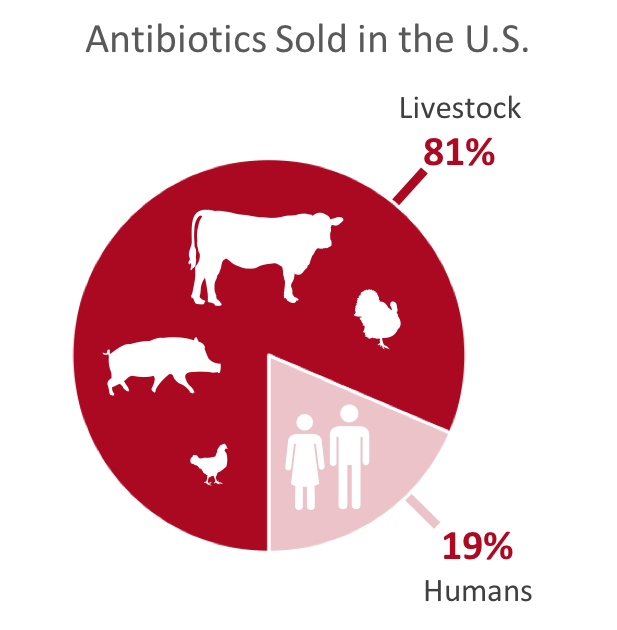
How much antibiotics are given to livestock?
Antibiotics have been used in livestock farming since the 1950s.(4) However, the FDA only started monitoring the quantity of antimicrobial drugs sold for livestock use in 2008.
In 2015, 34.3 million pounds of antibiotics were sold for use in food producing animals, a more than 20% increase since the sales data started to be reported in 2009.(5)
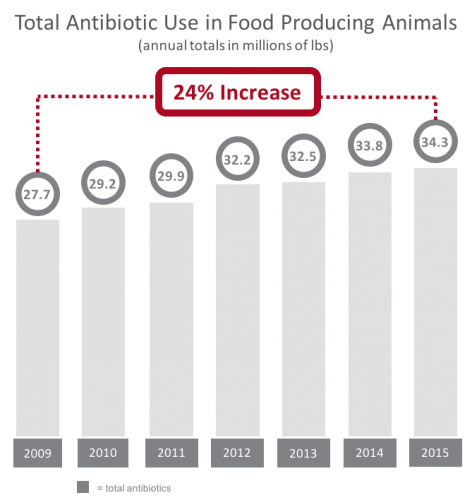
The FDA only monitors the quantity and types of antibiotics sold for use in livestock. They do not collect data on why the livestock are given the antibiotics or even which species are administered the antibiotics.
It is therefore hard to know exactly which animals are being fed antibiotics and why they are given them.
More than half of all the antibiotics given to animals are considered "medically important" antibiotics
More than half of the antibiotics given to animals are the same or similar to those used in human medicine. In 2015, 62% (or 21.3 million pounds) of the antibiotics given to animals were considered "medically important" by the FDA.(3)
The FDA defines medically important antimicrobial drugs as "antimicrobial drugs that are important for therapeutic use in humans."(6) However, unlike when we are prescribed antibiotics to treat an illness or an infection, livestock are rarely given antibiotics under the direction of a veterinarian. In fact, 97% of the antibiotics dispensed in 2015 were dispensed to farmers over the counter.(3) Whereas humans need prescriptions for antibiotics, farmers buy them the same way we buy Tylenol or Advil.
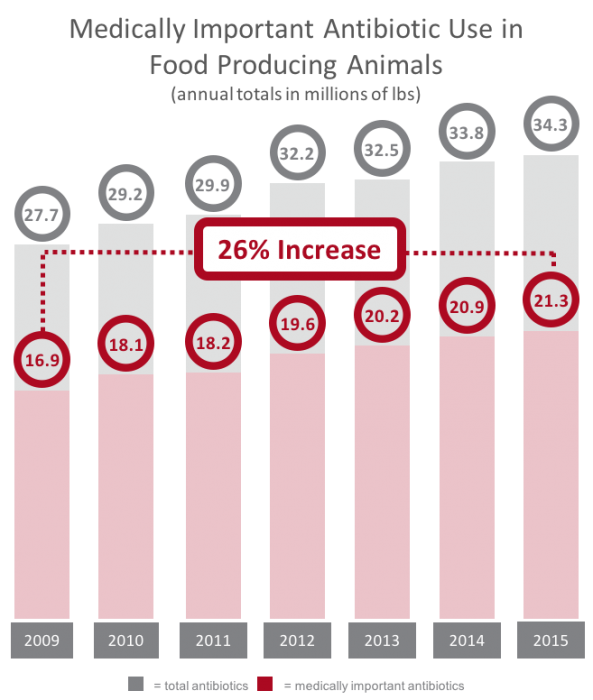
There has been similar growth in antibiotic use of medically important antibiotics in the past seven years. Between 2009 and 2015, there was a 26% increase sales of medically important antibiotics for use in food producing animals. In 2014, almost three times more medically important antibiotics were given to animals than people.(2,3)
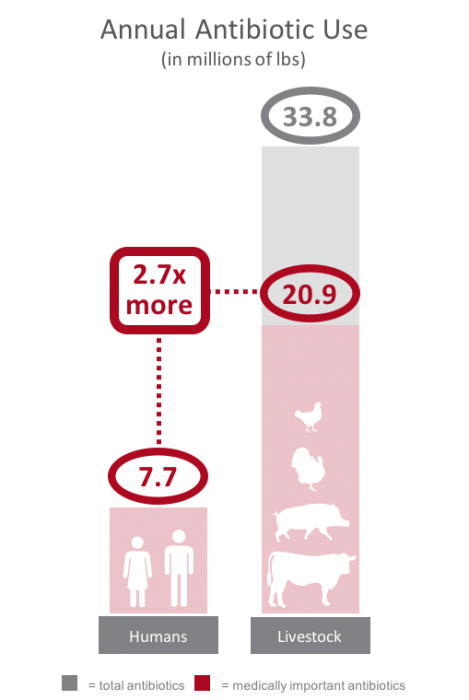
Why livestock are given antibiotics
There are four primary reasons why antibiotics are given to food producing animals:
1. Treatment of Sick Animals
The use of antibiotics to treat sick livestock is similar to that of humans. Antibiotics are administered to the unhealthy animal at a therapeutic dose for a specific time period. Using antibiotics in these situations is both necessary and, in some cases, required by law.(7)
2. Disease Control
Antimicrobials are administered to healthy livestock if they are at risk of infection or illness. For example, if some animals at a farm are sick, antibiotics can be given to healthy animals to prevent disease transmission.
3. Disease Prevention (Prophylactic Use)
Antibiotics are administered proactively in situations where there is a history of illness. Instances where antibiotics are given prophylactically can include during transportation or when cattle are contained in crowded feed lots. These situations are common for livestock raised on industrial farms.(8)
4. Promote Growth (Production Use)
Antimicrobials are administered to healthy livestock to promote growth. Feeding livestock low levels of antibiotics causes them to grow bigger and faster.(2)
The antimicrobial drugs used to promote growth are often the same as those used to treat and prevent disease, including some that are considered medically important.
Use of antibiotics to promote animal growth has been illegal in Europe since 2006.(9)
Appropriateness of Antibiotic Use in Food Producing Animals
It is hard to know just how much of the 34.3 million pounds of antibiotics sold for livestock in 2015 were for treatment of infections and disease and how much were for preventative or growth promoting purposes.
Although we don't know why animals are given antibiotics, we can presume the reason based on how they are delivered. According to the FDA, 95% of all antimicrobials administered to livestock in 2015 were delivered through their feed or water.(3) Only 5% of all antimicrobials administered were through therapeutic methods, such as oral, topical or injection. It stands to reason that the 95% of antibiotics given to animals in their food and water are not for treating sick animals or for controlling disease. If they were, the antibiotics would be delivered in a method consistent with therapeutic treatment.

Canada follows a similar trend as the US with regard to how antibiotics are administered to livestock. Specifically, the antibiotics given to food producing animals grown in Canada in 2014 were administered as follows: 84% feed, 8% water, 6% injections and 2% oral or topical.(10)
Should we give livestock non-therapeutic antibiotics?
Experts at the World Health Organization say no.(11) In fact, there is a large push to move away from using antibiotics to promote growth and prevent disease in food producing animals.
Over the past twenty years, countries in Western Europe have taken steps to reduce the amount of antibiotics used for growth promotion and disease prevention. As a result, the US currently uses 2 to 8 times more antibiotics than comparable countries in Western Europe.(2)
Why we should reduce the amount of antibiotics used in animal agriculture
1. Development of antibiotic resistant bacteria
Simply using antibiotics creates resistance, and antibiotic resistance is accelerated by the misuse and overuse of antibiotics.(11) Every time antibiotics are used, sensitive bacteria are killed but resistant bacteria survive and then multiply.(12) The World Health Organization (WHO), Centers for Disease Control and Prevention (CDC), and European Centre for Disease Prevention and Control (ECDC) are just a few notable groups that are trying to raise awareness about antimicrobial resistance as a growing global health crisis.(1,11,13)
The U.S. National Academy of Medicine warns that the "loss of antibiotic efficacy threatens to return society to a time when one in ten patients with a skin infection died and one in three patients with pneumonia died."(1)
What does growing antibiotic resistance in human medicine have to do with treating animals with antibiotics?
What does increasing antibiotic resistance in human medicine have to do with treating animals with antibiotics?
A lot. According to the U.S. National Academy of Medicine, "there is a direct link between antibiotic use on farms and the spread of antibiotic resistant bacteria to human populations."(2)
Nontherapeuctic use (for growth or to prevent disease) of antibiotics has been shown to create antibiotic resistant bacteria.(8)
Resistant bacteria develop in livestock and can be transferred to people two ways: either through coming in contact with the animals directly on the farm, or by handling or consuming meat contaminated with resistant bacteria.(14)
These resistant bacteria can also spread into the environment from animal waste, causing contamination of fruits and vegetables.
Antibiotic resistant bacteria make us sick
The CDC conservatively estimates 2 million illnesses and 23,000 deaths are the result of antibiotic resistance each year in the United States.(1)
It would be a mistake to think we can solve the growing crisis of antibiotic resistance by focusing only on the antibiotics used in human medicine, especially since they only account for 20% of the antibiotics sold today in the United States.
2. Meat from animals treated with antibiotics often contains resistant bacteria
More than 400,000 Americans get sick each year by consuming food containing drug resistant bacteria.(15)
Children younger than 5 years old have the highest incidence rate for infections from consuming these contaminated foods.(8)
Animals raised with antibiotics will naturally develop resistance, encouraging growth of resistant bacteria. These resistant bacteria are often transferred from the animal to their processed meat.
Final thought about antibiotics and our meat supply
For antibiotics to stay effective, we all have to use them properly. Both in human medicine and in how we raise livestock. We should not tolerate the misuse or abuse of antibiotics in livestock farming. The societal consequences are simply not worth it.
The United States is beginning to implement policies on the use of antibiotics in food animal farming. Earlier this year, the FDA completed the implementation of Guidance for Industry #213.(16) This guidance requires veterinary oversight for medically important antibiotics and eliminates the use of these antibiotics to promote livestock growth. However, it should be noted that following GFI #213 is voluntary and does not address the use of medically important antibiotics disease prevention. It will take a few years to see if this new guidance decreases the use of antibiotics in raising livestock. Until then, there are a few things that we can do.
How can you make sure you are buying meat that was raised without antibiotics?
The looming threat of antibiotic resistance is a global healthcare crisis. However, we each have an economic vote that we can voice by making wise decisions when purchasing meat. Some of the actions we can take include:
1. Buy organic meat
Antibiotics are prohibited in organic livestock farming. Livestock certified as organic must be raised "without antibiotics."(7)
That doesn't mean that sick animals are not treated. If preventative wellness strategies fail and an animal becomes sick, the animal must be given antibiotics.
However, as soon as antibiotics are administered, that animal and any product from it may not be sold as as organic.(7)
2. Look for "no antibiotics added" on packaging
The USDA has stringent labeling requirements for meat and poultry. The claims "no antibiotics added" and "raised without antibiotics" can be used if sufficient documentation is provided to the USDA demonstrating that the animals were raised without antibiotics.(17,18)
3. Shop at retailers that exclusively sell meat raised without antibiotics
There are a few grocery store chains to that are committed to selling meat raised entirely without antibiotics. Whole Foods has a policy of "no antibiotics, ever."(20)
Costco is in the process of phasing out selling chicken raised with medically important antibiotics.(21)
If you are unclear about whether meat raised without antibiotics is available where you shop, ask your grocer about how the animals were raised.
4. Choose to eat at restaurants that use meat raised without antibiotics
Several fast food chains are phasing out the use of meat raised with antibiotics.
Check out this post for a comprehensive review of restaurants that serve antibiotic-free meat.
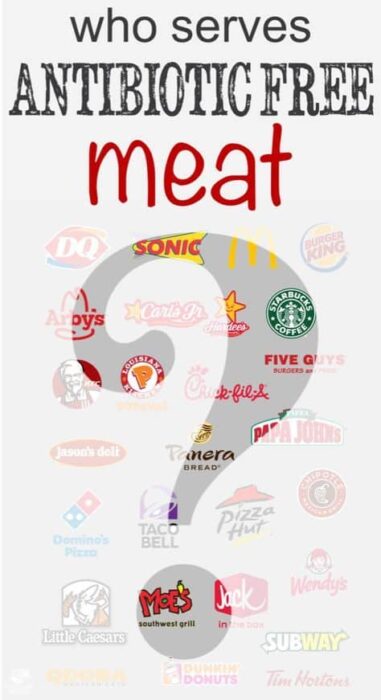
References:
- Antibiotic Resistant Threats in the United States, 2013, CDC Website (link)
- Antibiotic Resistance in Humans and Animals, Discussion Paper, National Academy of Medicine Website, 2016 (link)
- Antimicrobials Sold or Distributed for Use in Food-Producing Animals, 2015 Summary Report, FDA Website, Dec 2016 (link)
- Antimicrobial use and antimicrobial resistance trends in Canada: 2014, Public Health Agency of Canada Website (link)
- Effects on Human Health of Subtherapeutic Use of Antibiotics in Animal Feeds, National Research Council Committee to Study the Health Effects of Subtherapeutic Antibiotic Use in Animal Feeds, 1980 (link)
- Evaluating the Safety of Antimicrobial New Animal Drugs with Regard to Their Microbiological Effects on Bacteria of Human Health Concern, FDA Guidance for Industry #152, Appendix A , FDA Website, 2003 (link)
- Organic Livestock Requirements, USDA Website (link)
- Nontherapeutic Use of Antimicrobial Agents in Animal Agriculture: Implications for Pediatrics, Pediatrics, June 2015, AAP Website (link)
- Antibiotic resistance – is the meat we eat fueling a ticking time bomb?, European News, 2016 (link)
- Canadian Antimicrobial Resistance Survalence System Report, Public Health Agency of Canada Website, 2016 (link)
- Antibiotic Resistance, World Health Organization Website (link)
- Antibiotic Resistance Questions and Answers, Centers for Disease Prevention and Control (CDC) Website (link)
- Antimicrobial resistance surveillance in Europe 2012, European Centre for Disease Prevention and Control Website (link)
- Protecting the Food Supply, CDC Website (link)
- America's Antimicrobial Crisis: Making the World Safe From Super Bugs, Consumer Reports Website, Nov 2015 (link)
- FDA Announces Implementation of GTI#213, FDA Website (link)
- Meat and Poultry Labeling Terms, USDA Website (link)
- US Standards for Livestock and Meat Claims, FDA Website (link)
- What does "Meat raised without antibiotics" mean – and why is it important?, The Washington Post, 2015 (link)
- "No antibiotics, ever" Whole Foods policy on antibiotics, Whole Foods website, 2012 (link)
- Costco working to phase out selling chicken raised with medically important antibiotics, Reuters Website, Mar 2015 (link)
- "No antibiotics important to human medicine" ahead of schedule 2016 only in chickens, McDonalds Website (link)
- "No antibiotics in chicken, ham, roast turkey, or breakfast sausage" Panera Bread's Food Policy Statement, 2014 Panera Website (link)
- "Only therapeutic use of antibiotics" Chipotle Food Integrity Policy, Chipotle Website (link)
- "No Antibiotics Ever" by 2019, Chick-fil-A Website (link)
Source: https://feedthemwisely.com/antibiotics-in-livestock
0 Response to "Continued Subtherapeutic Use of Antibiotics in Livestock Feed"
Post a Comment